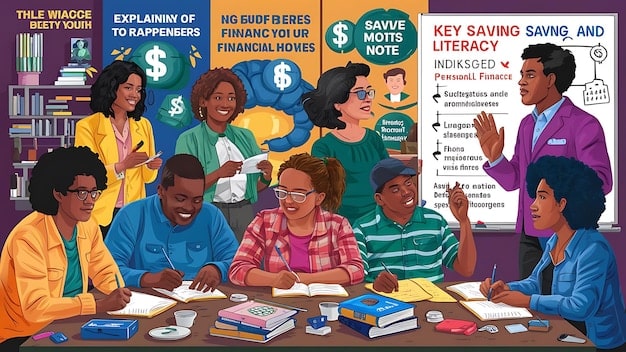Financial Planning for Educators: Maximize Retirement

Effective financial planning for educators involves understanding unique retirement systems and leveraging specific investment opportunities to maximize savings and ensure a secure financial future.
For educators, navigating the complexities of personal finance and planning for a secure retirement can feel like an overwhelming task. However, with strategic Financial Planning for Educators: Maximizing Retirement Savings and Investment Opportunities, it is entirely possible to build a robust financial future. This guide aims to demystify these processes, offering actionable insights tailored specifically for those dedicating their lives to education.
Understanding Educator Retirement Systems
Educators often participate in unique retirement systems that differ significantly from those in the private sector. These systems typically fall into two main categories: defined benefit plans (pensions) and defined contribution plans (like 403(b)s and 457(b)s). Understanding the nuances of your specific plan is the cornerstone of effective retirement planning.
Defined benefit plans promise a specific payout at retirement, often based on years of service and salary. While these can offer a stable income, they may also limit portability if you change states or districts. Defined contribution plans, on the other hand, rely on contributions from you and your employer, with the retirement benefit depending on investment performance.
Defined Benefit Plans: Pensions for Predictability
Many educators are still covered by traditional pension plans. These plans offer a predetermined monthly income upon retirement, providing a level of predictability that can be comforting. The value of your pension is usually calculated using a formula that considers your highest average salary and the number of years you’ve worked in the system. It’s crucial to understand your vesting schedule, which dictates how long you must work to earn a right to your pension benefits.
- Understand your pension formula: Know how your future income is calculated.
- Vesting requirements: Ensure you meet the minimum service years to qualify.
- Early retirement penalties: Be aware of reductions for retiring before full eligibility.
- Cost-of-living adjustments (COLAs): Check if your pension includes inflation protection.
While pensions offer security, they can sometimes be less flexible than other options. Educators should also consider if their pension is fully funded and what implications that might have for future payouts. Some systems offer options for lump-sum distributions versus monthly annuities, each with its own set of tax implications and financial considerations.
Defined Contribution Plans: Control and Growth Potential
For educators, 403(b) and 457(b) plans are the equivalents of 401(k)s in the private sector. These plans allow you to contribute pre-tax dollars, which grow tax-deferred until retirement, or after-tax dollars via Roth options, allowing for tax-free withdrawals in retirement. The key advantage of these plans is the control you have over your investment choices and the potential for greater growth, albeit with more market risk.
Maximizing contributions to these plans is a common strategy. If your employer offers a match, contributing at least enough to receive the full match is essentially free money. Understanding the investment options available within your plan, such as mutual funds, exchange-traded funds (ETFs), or target-date funds, is vital for long-term growth.
Both 403(b) and 457(b) plans offer different deferral limits and withdrawal rules. A 457(b) plan, often found in governmental entities, can sometimes allow penalty-free withdrawals upon separation from service, regardless of age, which offers a unique flexibility not always found in other retirement accounts. Always consider these features when prioritizing your contributions.
Optimizing Retirement Savings Strategies
Beyond understanding the specific retirement plans, there are broader strategies educators can employ to optimize their savings. This includes leveraging supplementary savings vehicles, understanding tax advantages, and making informed decisions about contribution levels. Many educators, due to their often modest salaries, need to be particularly diligent in finding every opportunity to save effectively.
Leveraging Supplementary Savings Vehicles
While employer-sponsored plans are foundational, they often aren’t enough on their own. Individual Retirement Accounts (IRAs), both Traditional and Roth, serve as excellent supplementary tools. Traditional IRAs offer tax-deductible contributions and tax-deferred growth, while Roth IRAs allow for after-tax contributions and tax-free withdrawals in retirement. The choice between the two depends on your current income level and your expected tax bracket in retirement.
Health Savings Accounts (HSAs) can also double as powerful retirement savings tools for those with high-deductible health plans. Contributions are tax-deductible, growth is tax-free, and withdrawals for qualified medical expenses are also tax-free. At age 65, HSA funds can be withdrawn for any purpose without penalty, taxed only as ordinary income if not used for medical expenses, essentially acting like a super-charged IRA.
For educators looking for even more flexibility, taxable brokerage accounts can complement retirement savings. While these accounts don’t offer the same tax advantages as retirement plans, they provide liquidity and control over your investments, allowing you to invest in a broader range of assets. Diversifying across different account types provides both dedicated retirement savings and accessible funds for other financial goals.
Understanding Tax Advantages and Contribution Limits
The tax treatment of your retirement savings can significantly impact your net wealth in retirement. Understanding the difference between pre-tax and after-tax contributions, and when withdrawals are taxed, is crucial. Maxing out contributions to tax-advantaged accounts should always be a priority, especially when considering the power of compounding tax-free growth.
- Identify your contribution limits for 403(b)s, 457(b)s, and IRAs.
- Utilize catch-up contributions if you are age 50 or older.
- Understand the implications of pre-tax vs. Roth contributions.
- Be aware of income limitations for Roth IRA eligibility and Traditional IRA deductibility.
Furthermore, some states offer additional tax benefits for educators, such as credits for certain savings programs or deductions for specific professional expenses that can free up more income for savings. It’s beneficial to consult with a tax professional who understands state-specific nuances for educators to fully optimize these advantages.

Smart Investment Opportunities for Educators
Once savings are in place, the next step is making those savings work for you through smart investment choices. For educators, this means understanding risk tolerance, diversifying portfolios effectively, and making informed decisions about various investment vehicles available within their retirement plans and personal accounts. The goal is to balance growth potential with stability.
Diversifying Your Investment Portfolio
Diversification is key to managing risk and achieving long-term growth. This means spreading your investments across different asset classes, industries, and geographies. For educators, a diversified portfolio might include a mix of stocks (equities) for growth, bonds (fixed income) for stability, and potentially real estate or other alternative investments for further balance.
Within your 403(b) or 457(b) plan, you might find a selection of mutual funds or target-date funds. Target-date funds are a popular choice as they automatically adjust their asset allocation as you approach retirement. However, for those comfortable with more control, selecting individual low-cost index funds or ETFs can offer greater customization and lower fees over the long run.
Beyond traditional asset classes, consider diversifying across different investment styles (e.g., growth vs. value) and market capitalizations (e.g., large-cap vs. small-cap). Regular rebalancing of your portfolio ensures that your asset allocation remains aligned with your long-term goals and risk tolerance.
Considering Low-Cost Index Funds and ETFs
For many investors, including educators, low-cost index funds and Exchange-Traded Funds (ETFs) are excellent choices. These funds aim to track a specific market index, such as the S&P 500, offering broad market exposure with minimal management fees. Over the long term, these low fees can significantly contribute to overall investment returns compared to actively managed funds that often come with higher expense ratios.
- Equity index funds: Gain exposure to the stock market with low costs.
- Bond index funds: Provide stable returns and diversify against stock market volatility.
- Global diversification: Invest in international index funds for broader market exposure.
- Vanguard, Fidelity, and Schwab: Commonly offer a wide range of low-cost index funds and ETFs.
When selecting these funds, pay close attention to the expense ratio, tracking error, and the fund’s underlying holdings. While ETFs often offer more flexibility in trading like stocks, index mutual funds can be simpler for regular, automated contributions, which is ideal for consistent savings strategies.
Navigating Student Loan Debt and Financial Aid
Educators often carry significant student loan debt, which can impact their ability to save for retirement. However, there are unique programs and strategies available specifically for educators to manage this debt and even achieve loan forgiveness, freeing up more financial capacity for long-term savings and investments.
Public Service Loan Forgiveness (PSLF) Program
The PSLF program is a critical resource for many educators. It offers forgiveness for the remaining balance on Direct Loans after 120 qualifying monthly payments have been made under a qualifying repayment plan while working full-time for a qualifying employer. Most public and non-profit schools fall under the “qualifying employer” category.
Understanding the strict requirements for PSLF is vital. This includes ensuring your loans are Direct Loans (consolidating other types if necessary), being enrolled in an income-driven repayment (IDR) plan, and meticulously tracking your employment and payments. Many educators miss out on this due to misunderstandings about the rules. It’s often recommended to use the PSLF Help Tool on the Federal Student Aid website to track progress.
Even if PSLF is not an option, other income-driven repayment plans can lower your monthly payments, potentially allowing you to allocate more funds towards higher-interest debt or savings. Always explore all federal loan repayment options before considering private refinancing, as private loans typically do not qualify for federal forgiveness programs.
Teacher Loan Forgiveness and Other State Programs
Beyond PSLF, there are other federal and state programs designed to reduce the student loan burden for teachers. The Teacher Loan Forgiveness program, for instance, offers up to $17,500 in forgiveness for eligible math, science, or special education teachers who work for five consecutive years in low-income schools. This is a separate program from PSLF, and you cannot receive forgiveness for the same period of service under both programs.
Many states also offer their own loan forgiveness or scholarship programs to encourage individuals to teach in high-need areas or subjects. Researching state-specific initiatives can uncover additional opportunities for debt relief. These programs vary widely, so diligent research into your state’s department of education website or financial aid resources is highly recommended.
Strategically addressing student loan debt can dramatically improve an educator’s financial outlook. By reducing this burden, more income becomes available for contributing to retirement accounts, building an emergency fund, or pursuing other financial goals. The path to financial freedom often involves tackling debt head-on first.
Budgeting and Debt Management for Educators
Effective financial planning for educators must also include robust budgeting and smart debt management strategies. Given the unique salary structures and often modest pay for educators, making every dollar count is more important than ever. A clear budget and a plan to tackle high-interest debt can pave the way for increased savings and financial security.
Creating a Realistic Budget
A budget is the foundation of any sound financial plan. For educators, this means understanding where every dollar goes and identifying areas for potential savings. Start by tracking your income and expenses for a few months to get a clear picture of your spending habits. Categorize your expenses into fixed costs (rent/mortgage, loan payments) and variable costs (groceries, entertainment).
- Track all income and expenses for at least one month.
- Differentiate between fixed and variable expenses.
- Identify areas where spending can be reduced without significant lifestyle changes.
- Use budgeting apps or spreadsheets to simplify the process.
Once you have a clear picture, you can allocate your income to different categories, ensuring that savings and debt repayment are prioritized. The goal is not to restrict yourself entirely, but to ensure your spending aligns with your financial goals. Living within your means and avoiding unnecessary debt are crucial steps in building wealth.
Strategies for Managing High-Interest Debt
High-interest debt, such as credit card debt, can significantly hinder your ability to save and invest. Prioritizing the repayment of these debts is often the most financially beneficial strategy. Two common approaches are the debt snowball and debt avalanche methods.
The debt avalanche method focuses on paying off the debt with the highest interest rate first, regardless of the balance. This method saves you the most money on interest over time. The debt snowball method, conversely, involves paying off the smallest debt first to gain psychological momentum, then rolling that payment into the next smallest debt. While it may cost more in interest, it can be highly motivating for those who need quick wins.
Consider consolidating high-interest debt through a personal loan with a lower interest rate, or exploring balance transfer credit cards with promotional 0% APR periods. Always read the fine print and understand the fees associated with these options. Reducing debt frees up more disposable income, which can then be channeled directly into your retirement savings.
Long-Term Care Planning and Estate Considerations
For educators, long-term care planning and estate considerations are critical components of a comprehensive financial strategy. These elements ensure that your assets are protected, your wishes are honored, and your financial well-being, and that of your loved ones, is secure in the face of unforeseen circumstances or advanced age.
Planning for Long-Term Care Needs
Long-term care is an increasingly important consideration as lifespans increase. It encompasses a range of services, from assisted living to in-home care, and is typically not covered by standard health insurance or Medicare. The costs can be substantial, potentially eroding retirement savings if not planned for.
Options for funding long-term care include dedicated long-term care insurance policies, hybrid policies that combine life insurance with long-term care benefits, or self-funding through personal savings. Researching the costs of care in your specific region and understanding the eligibility requirements for insurance are crucial initial steps.
Even if insurance isn’t feasible, setting aside dedicated funds in a separate investment account or HSA, if eligible, can offer a degree of financial preparedness. Discussing these plans with family members can also alleviate future burdens and ensure everyone is aware of your preferences and preparations.
Basic Estate Planning for Educators
Estate planning is not just for the wealthy; it’s an essential process for everyone, including educators, to ensure their assets are distributed according to their wishes and to minimize potential family disputes or probate complications. A basic estate plan typically includes a will, powers of attorney, and potentially a living trust.

A will dictates how your assets will be distributed after your death and allows you to name a guardian for minor children. A durable power of attorney for finances grants someone the authority to manage your financial affairs if you become incapacitated, while a healthcare power of attorney (or advance directive) allows someone to make medical decisions on your behalf.
- Draft a will: Specify asset distribution and guardianship for minors.
- Establish powers of attorney: Financial and healthcare directives.
- Review beneficiary designations: Ensure retirement accounts and life insurance align with your wishes.
- Consider a living trust: For potentially avoiding probate and ensuring privacy.
Regularly reviewing and updating your estate plan is as important as creating it. Life events such as marriage, divorce, births, or deaths of beneficiaries should prompt a review. Seeking advice from an estate planning attorney can ensure your plan is legally sound and fully reflects your intentions.
Building a Resilient Financial Future
Building a resilient financial future for educators goes beyond simply saving; it involves continuous learning, adapting to life changes, and making informed decisions that align with long-term goals. The journey is ongoing, and proactive engagement with your finances is key to success.
Continuing Financial Education
The financial landscape is always evolving, from new investment products to changes in tax laws and retirement plan regulations. For educators, staying informed about these changes is crucial for optimizing financial strategies. This doesn’t mean becoming a financial expert, but rather understanding key concepts and knowing when to seek professional advice.
Many educational institutions and state retirement systems offer free workshops or resources on financial planning. Reputable non-profits and government agencies also provide valuable unbiased information. Podcasts, reputable financial news sites, and books written by certified financial planners can also be excellent sources of knowledge.
A commitment to continuous financial education equips you to make better decisions, recognize potential pitfalls, and adapt your plan as circumstances change. Financial literacy empowers you to take control of your financial destiny, rather than passively relying on others.
Adapting Your Plan to Life Changes
Life is dynamic, and your financial plan should be too. Major life events like marriage, divorce, having children, changing jobs, or facing unexpected health issues all require a review and potential adjustment of your financial strategy. What worked for you in your 20s or 30s may not be appropriate in your 50s or 60s.
Regularly scheduled financial reviews—perhaps annually or biennially—are essential. These check-ins allow you to assess your progress toward your goals, re-evaluate your risk tolerance, and make necessary adjustments to your budget, savings rate, and investment portfolio. Consider working with a fee-only financial advisor who acts as a fiduciary, meaning they are legally bound to act in your best interest.
Ultimately, the goal of financial planning for educators is to create a secure and flexible framework that supports your aspirations, both professional and personal. By understanding your unique retirement opportunities, optimizing savings and investments, managing debt effectively, and planning for the long term, educators can achieve significant financial independence and peace of mind.
| Key Point | Brief Description |
|---|---|
| 📚 Retirement Systems | Understand your unique pension (defined benefit) and 403(b)/457(b) (defined contribution) plans. |
| 📈 Investment Strategies | Diversify with low-cost index funds/ETFs for growth and risk management. |
| 👩🎓 Student Loan Aid | Leverage PSLF and other teacher-specific forgiveness programs to reduce debt. |
| 💡 Financial Literacy | Continuously learn about personal finance and adapt your plan to life’s changes. |
Frequently Asked Questions
Educators typically participate in defined benefit plans (pensions) or defined contribution plans like 403(b)s and 457(b)s. Pensions provide fixed monthly payments based on service, while 403(b)s and 457(b)s involve individual investment contributions and growth, offering more control over investment choices and risk exposure.
To maximize savings, educators should prioritize contributing to employer-sponsored plans (especially if there’s an employer match), utilize supplementary accounts like Traditional or Roth IRAs, and explore Health Savings Accounts (HSAs) if eligible. Understanding and leveraging tax advantages specific to their situation is also crucial for long-term growth.
Educators should focus on diversifying their investment portfolios across different asset classes. Low-cost index funds and ETFs are often recommended for their broad market exposure and minimal fees. These funds can significantly contribute to overall investment returns over the long term, balancing growth potential with manageable risk.
Yes, educators can benefit from programs like Public Service Loan Forgiveness (PSLF), which forgives federal loan balances after 120 qualifying payments for full-time public service employees. Additionally, the Teacher Loan Forgiveness program offers up to $17,500 in forgiveness for eligible teachers in low-income schools. State-specific programs may also be available.
Long-term care planning is crucial because standard health insurance and Medicare typically do not cover extensive long-term care needs, which can be very expensive. Planning ensures that potential future care costs do not deplete retirement savings. Options include long-term care insurance, hybrid policies, or self-funding through dedicated savings.
Conclusion
Navigating the intricacies of personal finance can be a daunting, yet incredibly rewarding, endeavor for educators. By systematically understanding the unique facets of their retirement systems, strategically leveraging diverse investment opportunities, diligently managing student loan obligations, and maintaining a robust budgeting framework, educators can establish a powerful foundation for their financial well-being. Ultimately, committing to continuous financial education and adapting plans to life’s inevitable changes ensures a resilient and fulfilling financial future, allowing those who dedicate their lives to teaching to also secure their own later years.





